The Global Luxury Jewelry Market is estimated to be valued at USD 57.13 Bn in 2025 and is expected to reach USD 98.60 Bn by 2032, exhibiting a compound annual growth rate (CAGR) of 8.1% from 2025 to 2032.
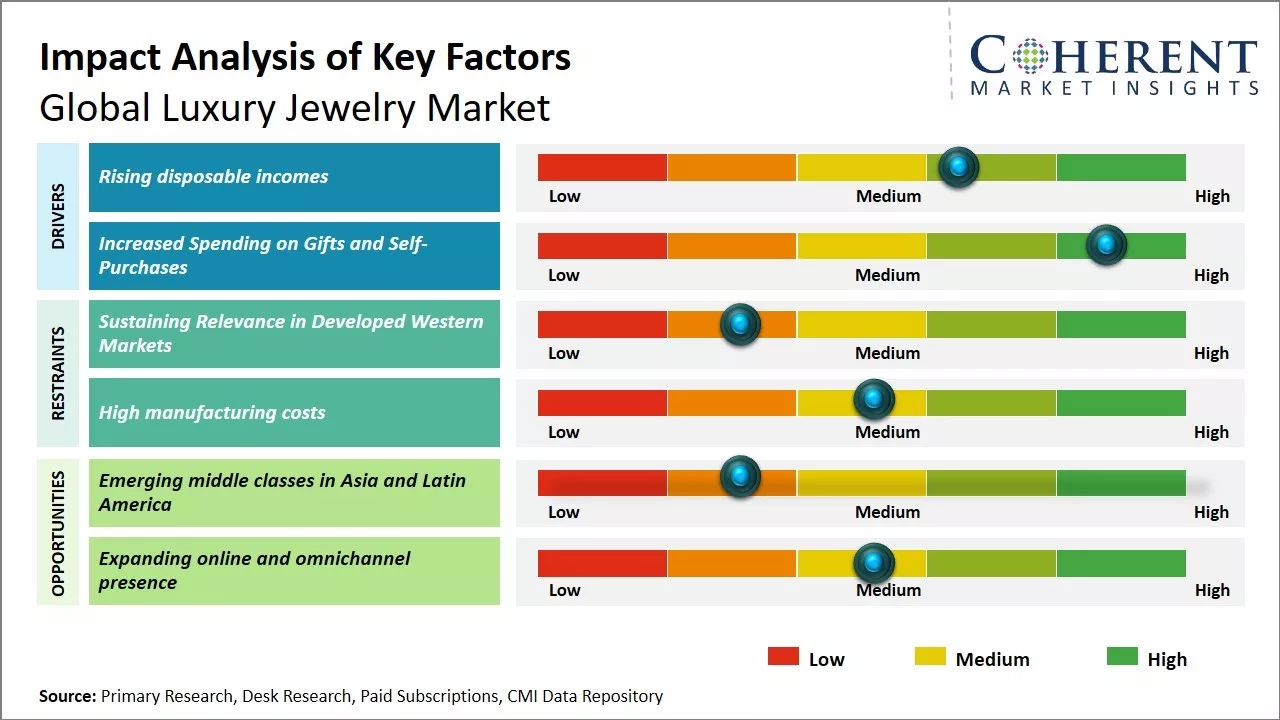
Discover market dynamics shaping the industry: Request sample copy
The luxury jewelry market is expected to witness positive growth over the forecast period. The growing millennial population with increasing spending power is expected to drive the demand. Moreover, changing lifestyle and fashion trends have encouraged consumers to spend more on luxury jewelry to flaunt social status. Furthermore, rising adoption of online channels by key players to boost sales is anticipated to provide potential growth opportunities for the market expansion. However, pricing volatility of precious metals and gemstones may hamper the market growth. Nonetheless, market players can explore opportunities in emerging economies to further penetrate into untapped markets.
Rising disposable incomes
Rising disposable incomes across various economies have significantly contributed to the growth of the global luxury jewelry market in recent years. As per World Data Lab, the global middle class population is expected to grow by over 1 billion people between 2019 to 2025. This rapid growth in middle and upper middle income population has increased their purchasing power. With higher disposable incomes, people are able to spend more on luxury and premium products instead of just necessities. Luxury jewelry products such as diamonds, gemstones, gold and silver jewelry have become affordable indulgences for the rising middle class consumers in developing nations. As per United Nations DESA report, disposable incomes in Asia and Africa are projected to rise substantially between 2020-2023. This will enable more consumers in large developing countries like China, India and Nigeria to buy expensive luxury adornments. For example, the per capita annual disposable income in China increased from USD 7,174 in 2015 to over USD 10,000 in 2020 according to National Bureau of Statistics China. Similarly, the average disposable income in India has doubled from INR 62,671 in 2015 to INR 131,715 in 2020 as per Centre for Monitoring Indian Economy. The growing wealth has encouraged consumers across various income segments to purchase luxury and branded jewelry on special occasions, festivals and also to flaunt their social status. Luxury jewelry brands are launching affordable as well as premium product lines to tap both the premium and mass markets. They are also expanding their retail presence in developing markets through both offline and online channels. The burgeoning demand has attracted several new players while existing brands are diversifying and customizing their offerings. As disposable incomes continue to rise in the medium term in emerging economies, the global luxury jewelry industry is slated for further growth in the coming years.
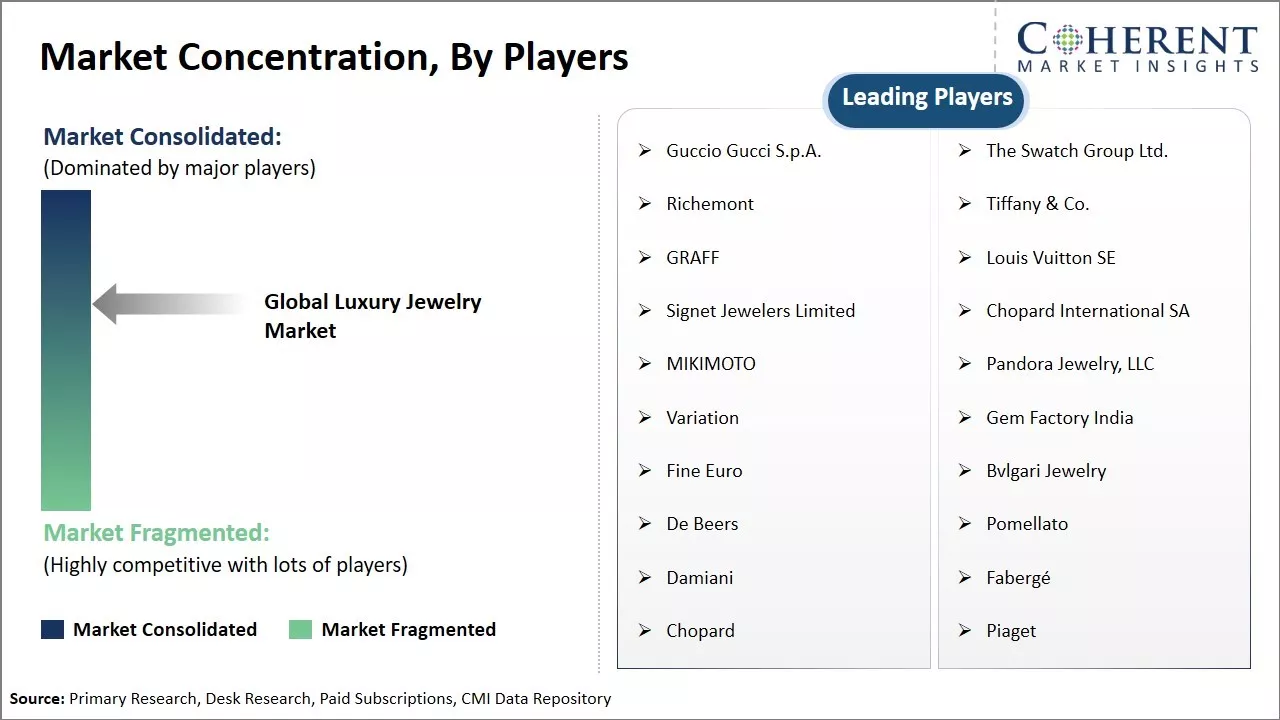
Get actionable strategies to beat competition: Request sample copy
Increased Spending on Gifts and Self-PurchasesLuxury jewelry is commonly gifted during festive seasons, weddings and other ceremonies or events to express affection, congratulate, and wish well to friends and family. Diamonds in particular are associated with feelings of love and commitment. Growing economies have led to an expanding middle class with greater expenditure capabilities on buying gifts. Even in premium segments, jewelry receives preference for gifting purposes due to its ability to make a strong social statement and last forever as a keepsake. Other than gifting, people are allocating higher budgets towards self-purchases and indulgences to treat themselves. Jewelry satisfies the desire to own something precious and aesthetically appealing. Rising work pressures too have made stress-busting through luxury treats more acceptable. All these have stimulated luxury jewelry buying for both gifting as well as self-rewarding motivations. As global incomes and standard of living climb further, gifting and self-purchase spends on luxury jewelry segments are set for robust growth prospectively.
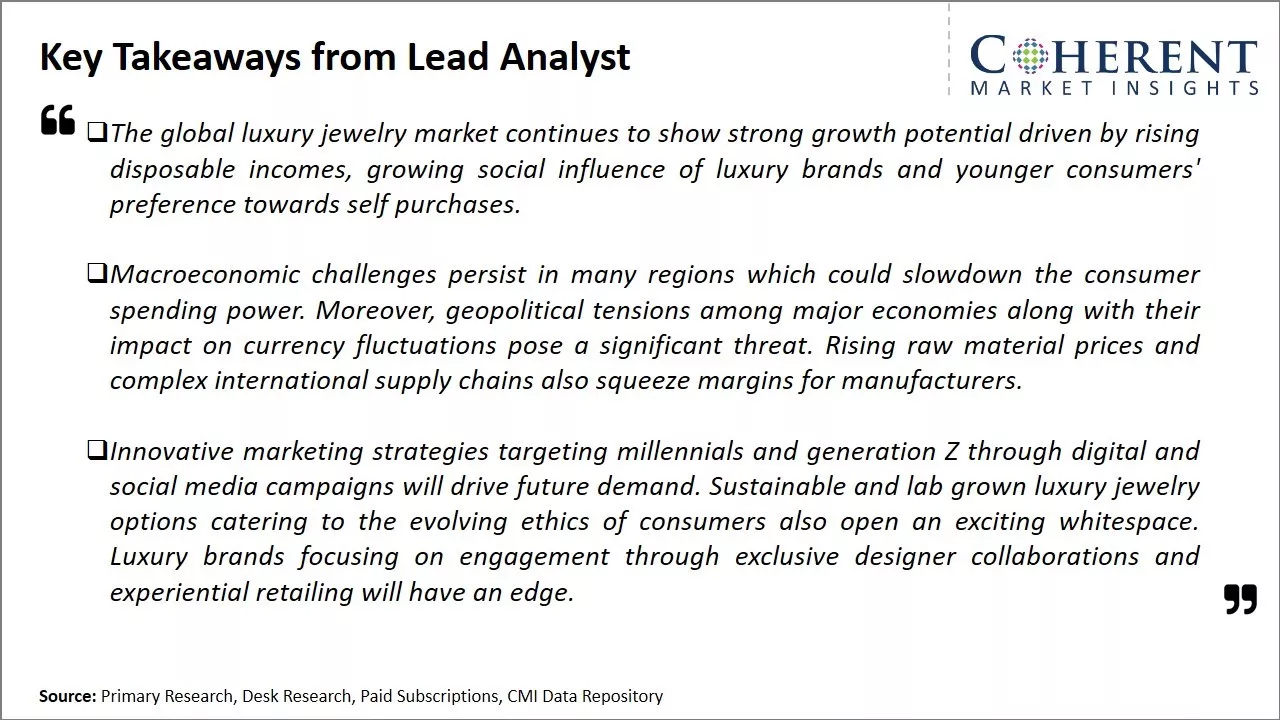
To learn more about this report, Request sample copy
Challenges: Sustaining Relevance in Developed Western MarketsAlthough sales are rising in emerging economies, developed Western markets remain integral to revenues. However, these markets face economic headwinds that can curb consumer spending. Additionally, access to inexpensive alternatives through e-commerce gives customers greater choice. Changing consumer preferences pose a threat as well, with younger spenders less brand-loyal and values-driven. Sustaining craftsmanship standards also challenges suppliers as costs rise. These combined factors necessitate ongoing innovation to delight discerning customers and strengthen brand image.
Opportunities: Emerging middle classes in Asia and Latin America
Emerging middle classes in Asia and Latin America continue to drive new demand. Experience-seeking millennials in these regions are prospective customers. Furthermore, digital technologies enable luxury brands to connect with audiences worldwide while improving marketing and services.
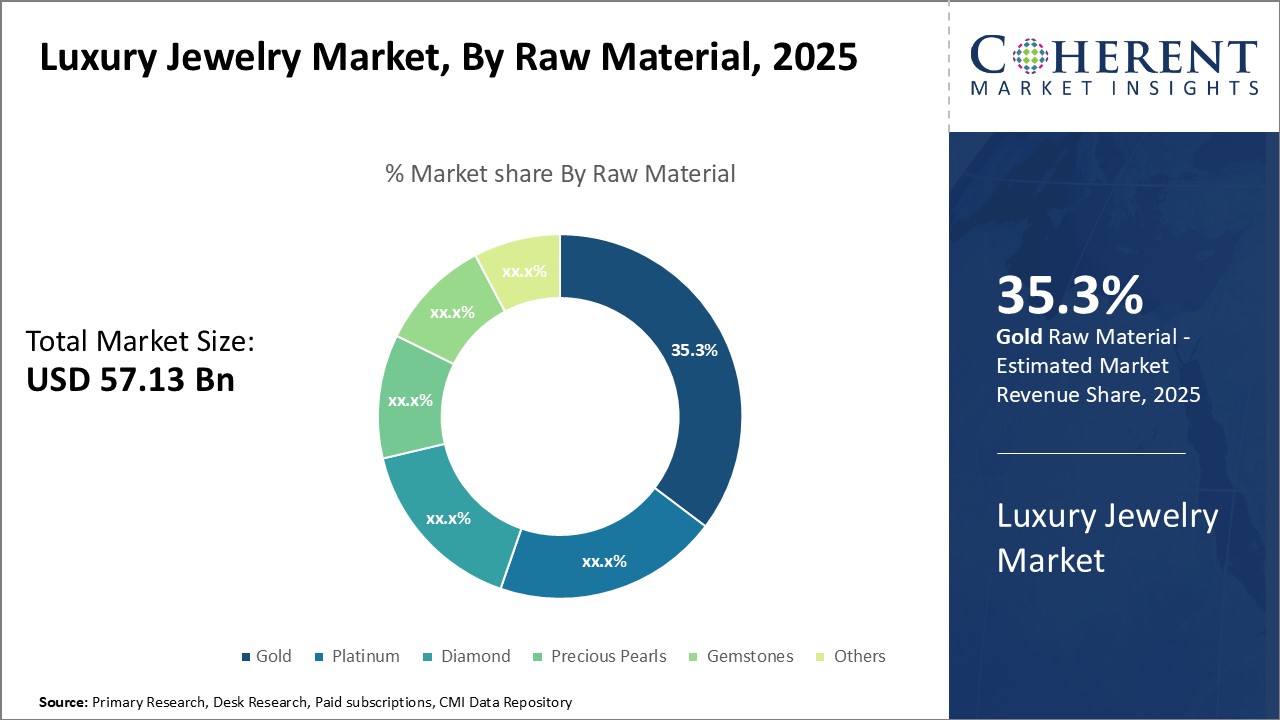
Discover high revenue pocket segments and roadmap to it: Request sample copy
Insights, By Raw Material: Precious Appeal and Versatility Drive Gold's DominanceGold has been a prized material for luxury jewelry for centuries due to its precious qualities and versatile applications in different jewelry designs. Being rare and possessing a distinctive golden luster, gold carries an aura of luxury that appeal to status-oriented consumers with 35.3% share in 2025. It can be formed into intricate designs and patterns with relative ease through casting and other metalworking techniques. This allows for wide product customization and differentiation according to consumer tastes and affordability. Gold is also durable and resistant to damage or tarnishing over long-term use. Jewelry made of gold is considered an heirloom piece and investment, passing through generations. The perception of gold as a store of value strengthens its appeal as a luxury item. Furthermore, gold pricing is directly linked to inflation through most economic cycles. So gold jewelry retains or appreciates its worth, unlike other depreciating assets. This positions gold as both adornment and potential source of future financial security for wealthy consumers. Due to its corrosion resistance, gold is hypoallergenic and skin-friendly. This property expands gold's customer base to include those with sensitive skin who may not prefer other alloyed metals in contact. Gold is also easily recycled and retains most of its purity through melting and reforming processes. This environmental sustainability aspect resonates well with newer generations who value responsible luxury consumption. Overall, gold's perfect alchemy of luxury symbolism, product versatility, financial credibility and practical advantages has made it the dominant material choice for the luxury jewelry segment.
Insights, By Product Type: Rings Symbolize Commitments and Relationships
Among different product types, rings dominate the luxury jewelry market owing to their significance in relationships and commitment ceremonies. Rings are exchanged during weddings, engagements and other relationship milestones as symbols of love, fidelity and family bonds with 36.1% share in 2025. Culturally ingrained traditions and social status considerations drive continued high demand for luxury rings during these occasions. Luxury rings also serve as public symbolic representations of social and marital status. Expensive precious metal and gem-set rings flaunted in public settings reaffirm one's position and accomplishments to peers. This social signaling drives fashionable and affluent consumers toward distinctive high-end ring designs for events and day-to-day wear. Additionally, rings are versatile enough to mix-and-match with day and evening attire of professional men and women. Iconic classic solitaire or cluster-set engagement rings also provide an avenue for gifting lavish pieces within relationships and courting rituals. Customized ring designs catering to individual tastes further reinforce personal bonds and memories between gifters and recipients. Overall, the emotional, cultural and social anchoring of rings in commemorating life occasions and status assertion has kept them the dominant luxury jewelry product type.
Insights, By Distribution Channel: Established Offline Dominates over Growing Online
The offline segment leads luxury jewelry sales globally due to traditional consumers still heavily relying on in-store experiences with 61.8% share in 2025. Showrooms and boutiques allow customers to see, try on and assess diverse designs and craftsmanship physically before expensive purchases. This tactile dimension builds greater confidence and trust compared to online visuals alone. Additionally, expert sales staff can offer bespoke customization guidance, maintenance advice and credible authenticity verification in-person. Established premium retail chains and boutiques also tap into walk-in tourist and business traveler segments across global luxury hubs. Convenient store locations in luxury malls and districts expose transient travelers to new collections amid leisure time or transit layovers. This assists brand discovery and fortuitous purchases aiding the offline segment. Simultaneously, the personal touch of offline service bolsters customer loyalty and repeat business through membership programs or referral incentives. While online luxury jewelry is gaining due to broader selections, convenient search and checkout benefits, it is still not seen as a replacement for an in-store experience by many traditional wealthy buyers. Internet security and quality verification doubts also impact the willingness to invest heavily online without physical assurance. Thus, the established infrastructure and experiential strengths of offline channels continue holding sway. However, omnichannel integration of both models is sure to spur further growth across segments.
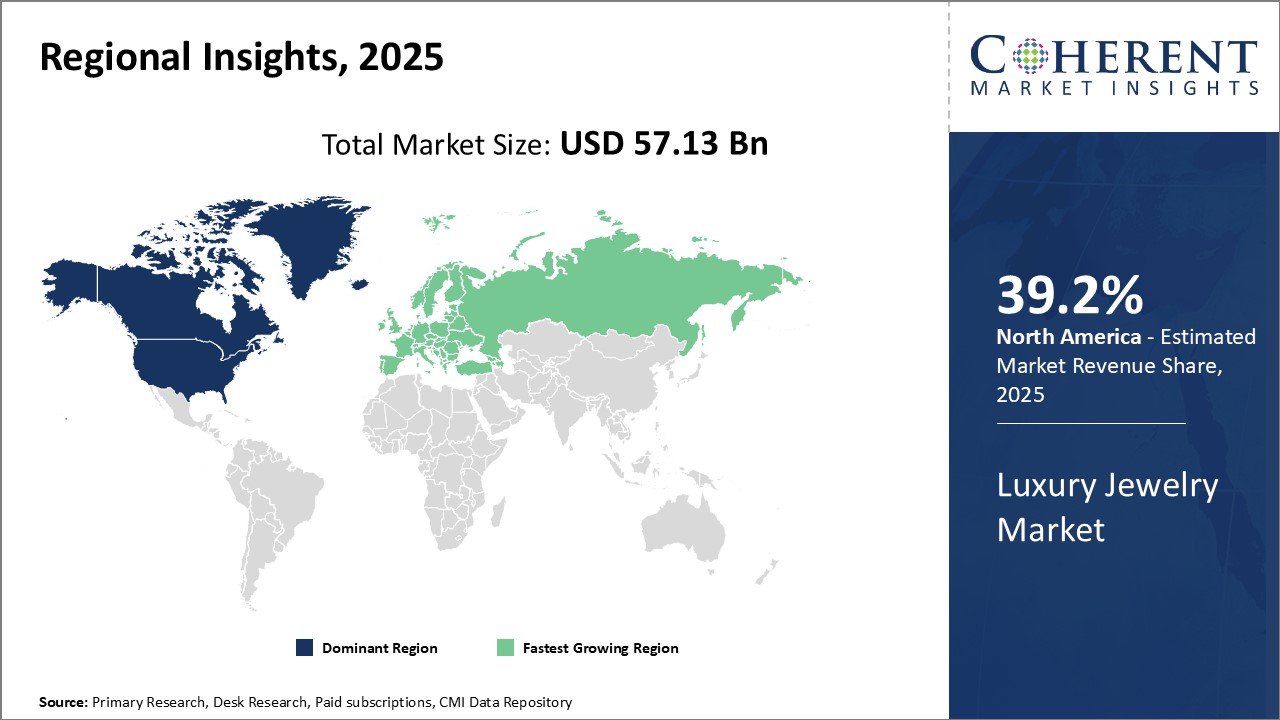
Need a Different Region or Segment? Customize now
The North American region has established its stronghold in the global luxury jewelry market for many decades with 39.2% share in 2025. With the presence of major luxury brands and designers, it leads in terms of market share. The U.S., in particular, is the dominant market within North America owing to the high demand for luxury jewelry and strong consumer spending power. Several luxury brands have their headquarters located in the U.S. cities such as New York, Los Angeles, and Miami which facilitates faster time to market and strong distribution networks. In addition, awareness about latest jewelry designs and trends is also very high amongst American consumers which helps sustain the demand. The competitive pricing adopted by U.S. brands also makes luxury jewelry affordable for middle-class consumers
The Middle East region has emerged as one of the fastest growing markets for luxury jewelry globally over the past decade. Within Middle East, the GCC countries such as UAE, Saudi Arabia and Qatar are at the forefront due to aggressive economic growth and rising affluence. The young population in these countries has a strong preference for flashy and lavish jewelry. In addition, auspicious occasions like weddings in the local culture boost gifting of luxury gold and diamond jewelry. The local jewelry manufacturers are constantly collaborating with European luxury brands to build localized product ranges and penetrate deeper into the retail market. This has resulted in UAE becoming a major gold trading and export hub within the region. E-commerce retailers have also strengthened their footprint in Middle East to tap the online potential of young digitally native consumers. The influx of wealthy international tourists and workers visiting GCC countries on a regular basis further stimulates the luxury sales.
Luxury Jewelry Market Report Coverage
| Report Coverage | Details | ||
|---|---|---|---|
| Base Year: | 2024 | Market Size in 2025: | USD 57.13 Bn |
| Historical Data for: | 2020 To 2024 | Forecast Period: | 2025 To 2032 |
| Forecast Period 2025 to 2032 CAGR: | 8.1% | 2032 Value Projection: | USD 98.60 Bn |
| Geographies covered: |
|
||
| Segments covered: |
|
||
| Companies covered: |
Guccio Gucci S.p.A., The Swatch Group Ltd., Richemont, Tiffany & Co., GRAFF, Louis Vuitton SE, Signet Jewelers Limited, Chopard International SA, MIKIMOTO, Pandora Jewelry, LLC, Variation, Gem Factory India, Fine Euro, Bvlgari Jewelry, De Beers, Pomellato, Damiani, Fabergé, Chopard, and Piaget |
||
| Growth Drivers: |
|
||
| Restraints & Challenges: |
|
||
Uncover macros and micros vetted on 75+ parameters: Get instant access to report
*Definition: The Global Luxury Jewelry Market consists of high-end jewelry items made from precious metals and gems. Manufacturers in this market craft exquisite one-of-a-kind pieces and limited collections featuring rare diamonds, precious stones, vintage designs and intricate craftsmanship. Luxury jewelry reflects status and wealth. It caters to high-net-worth individuals seeking intrinsically valuable, aesthetically beautiful works of art they can cherish and pass down for generations.
Share
Share
About Author
Yash Doshi is a Senior Management Consultant. He has 12+ years of experience in conducting research and handling consulting projects across verticals in APAC, EMEA, and the Americas.
He brings strong acumen in helping chemical companies navigate complex challenges and identify growth opportunities. He has deep expertise across the chemicals value chain, including commodity, specialty and fine chemicals, plastics and polymers, and petrochemicals. Yash is a sought-after speaker at industry conferences and contributes to various publications on topics related commodity, specialty and fine chemicals, plastics and polymers, and petrochemicals.
Missing comfort of reading report in your local language? Find your preferred language :
Transform your Strategy with Exclusive Trending Reports :
Frequently Asked Questions
Joining thousands of companies around the world committed to making the Excellent Business Solutions.
View All Our Clients
US Reciprocal Tax Impact Analysis On Luxury Jewelry Market
Stay updated on tariff changes with expert insights and timely information